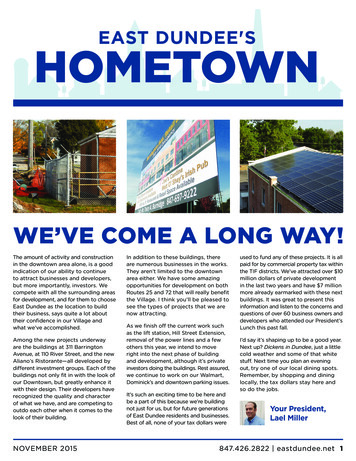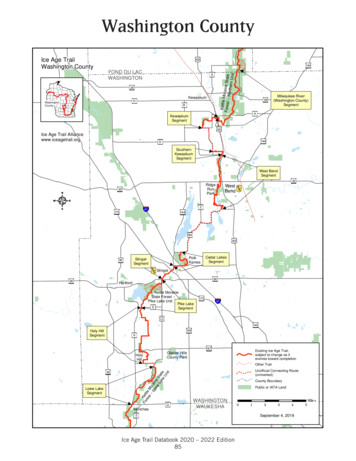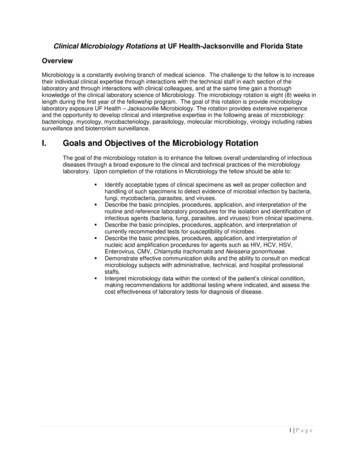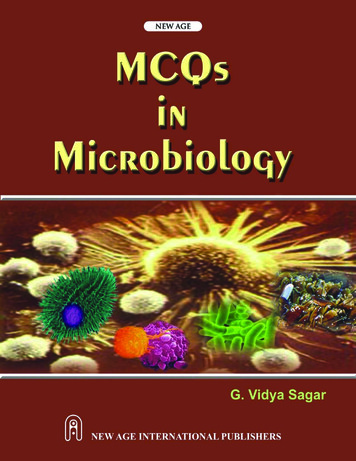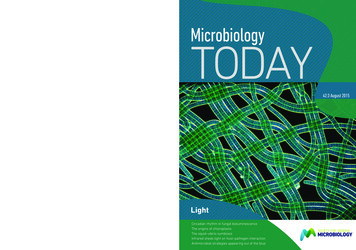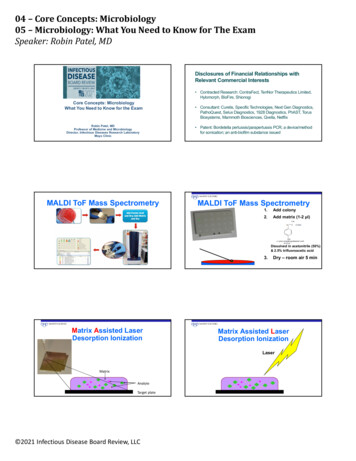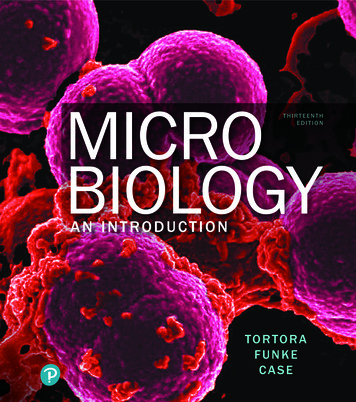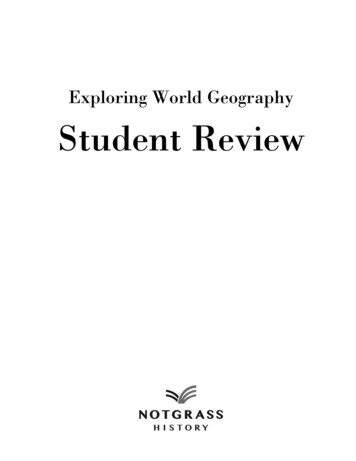
Transcription
University of DundeeExploring MicrobiologyGudynaite, Diana; Cameron, Amy; Floyd, Ali; Hardee, Erin; Mackintosh, Ailsa ; Mossey, PeterDOI:10.20933/100001176Publication date:2020Document VersionPublisher's PDF, also known as Version of recordLink to publication in Discovery Research PortalCitation for published version (APA):Gudynaite, D., Cameron, A., Floyd, A., Hardee, E., Mackintosh, A., Mossey, P., & Stanley-Wall, N. (2020).Exploring Microbiology. University of Dundee. https://doi.org/10.20933/100001176General rightsCopyright and moral rights for the publications made accessible in Discovery Research Portal are retained by the authors and/or othercopyright owners and it is a condition of accessing publications that users recognise and abide by the legal requirements associated withthese rights. Users may download and print one copy of any publication from Discovery Research Portal for the purpose of private study or research. You may not further distribute the material or use it for any profit-making activity or commercial gain. You may freely distribute the URL identifying the publication in the public portal.Take down policyIf you believe that this document breaches copyright please contact us providing details, and we will remove access to the work immediatelyand investigate your claim.Download date: 09. Apr. 2022
ExploringMicrobiology
Key WordsThere are a few key words you’ll need to know.The word microbe is shorthand for microorganism (mai-krow-aw-guh-ni-zm).Micro means small. What then, is an organism? You are one! So are dogs, cats,and all animals. Plants are organisms, and so are fungi. In fact, an individual ofanything that’s alive is an organism.Microorganisms might be tiny, but they come in a variety of shapes and(small) sizes. They live in a dazzling array of different places on the Earth,including on your skin and in your intestines!Archaea (are-key-ah) are a very ancient form of life. They can live inextreme environments, like the bottom of the sea, or in geothermal ventsbut they are also found in your bellybutton!Bacteria (back-tea-ree-ah) are the best known of the microbes. Theyare very distantly related to humans, so their cells are very different toours. Bacteria are found in lots of places.in the soil, in our food, or eveninside us! Some are harmful, but lots of them are super helpful.Eukaryotic (you-carry-oat-ick) microbes have cells with the samestructure as ours. They include organisms like fungus, which canbe helpful. Humans use a fungus called yeast to help them makedifferent types of food. Eukaryotic microbes also include diseasecausing parasites like Plasmodium falciparum, which causesmalaria.
Welcome to the worldof microbesYou will explore the amazing world of life at the far end of the microscope.While many microbes are too small to see without help, they have a hugeimpact in the world.Did you know that you have one microbe cell on or in your body for everyhuman cell? They live on your skin and in your mouth and in your intestines!Image credit: Erin HardeeYou can see the microbes that were livingon a hand. Someone placed their handon the agar plate (food for microbes) andtransferred what was on the skin. We cansee the microbes after they have grown inan incubator.1
2Microbes shapesand sizesBacteria and parasites are single-cell organisms that come in a variety of shapesand sizes. They are very adaptable and can live in almost all environments,partially due to the protective features that help them to survive and thrive.Many bacteria have a protective wall that lets them survive changes to theenvironment. Some bacteria have flagella (fla-jell-a), which act as propellers tolet the bacteria swim to find food and some are covered in dozens of tiny hairscalled pili to help them stick to me parasites also can move andpropel forward. For example, amoeba(ah-me-bah), a eukaryotic microbe,can change shape by extending feetlike projections used for ishmania donovani is a parasitewhich causes the deadly diseaseLeishmaniasis. It looks like it hasa tail – it’s called a flagellum (fla-jellum). It uses it to move – but unlikea tail, the flagellum goes at the frontand pulls the parasite along.
3Activity 1:Design your own microbeHave a go at drawing your own microbe. Be sure to give it a name.Questions to think about: What shape is it? Does it have any adaptations to help it survive in the environment? Is it a harmful or beneficial microbe? If it’s a helpful microbe, what is it used for?You could also have a go at modellingyour own microbe using differentmaterials! Here is an example ofa creation by one of our youngmicrobiologists for inspiration!Image Credit: Dr. Elliot Erskine
4Activity 2:microorganismWord finderHow many different words can you make using theletters in “microorganism”?We’ll start you off with the word “magic”! Now it’s your turn.Answers are on page 16
5Oral Health CareDid you know that one of the places that lots of microbes live is in our mouth?Toothbrushing with a fluoride toothpaste is one of the most effective ways to prevent decayand keep the teeth clean and healthy.Activity 3:ToothbrushingWhen you wake up in the morning run your tongue around yourmouth on your teeth. How do they feel? Shiny or furry? Thefurry feeling is caused by bacteria growing on your teeth. Thesebacteria produce acid that can break down the outer enamelwall of protection on your teeth and this is decay. For yourteeth to remain healthy and pain free you must clean them. Thenext time you grab your toothbrush and toothpaste follow ourinstructions.Toothbrushing Instructions:1. Brush twice a day preferably in the morning and last thing atnight2. Don’t have anything to eat or drink at night after brushingapart from water3. Use a fluoride toothpaste4. Brush for at least 2 minutes5. Do not brush for at least 30 minutes after eating or drinkingsomething acidic e.g. fruit juice6. Spit don’t rinse once you have cleaned all your teethHow to brush: Make sure all surfaces of the teeth have been brushed. Brush all surfaces of a section of the mouth before movingonto the next section in the mouth. Use a circular, short scrubbing motion when brushingHow do your teeth feel now? Shiny? Good work!Keep it up morning and night.Image credit: Toothy Tigers Robbie Macoy, Clement Seeballuckand Ayeza Tari
6LichensLichens are made of two types of eukaryoticmicrobes working together: Algae FungiLichens can survive in lots of different places andoften have fascinating colours and patterns.
7Image Credit: Prof. Nicola Stanley-Wall, University of DundeeActivity 4:Lichen HuntNext time you go out for a walk or cycle ride, look around you andsee how many different types of lichen you can find.You can look at trees, walls, signs, pavements, roof tiles, all over!Can you find any lichen samples?If you do, note down where you found it and what colour it was.
8Microbes in nature:Believe it or notLeaf-cutter ants:microbes – friend or foe?Did you know that leaf-cutter ants are expert farmers? Thesespecial ants go on long journeys to find fresh pieces of leavesthat they use to grow their food, a white fungus.Along the way, leaf-cutter ants can encounter a harmfulfungus that can destroy their fungus food! Thankfully, the antshave helpful bacteria that live on their bodies and can kill theharmful fungus.Image Credit: Prof. Matt Hutchings, University of East Anglia
9Activity 5:Spot the differenceCan you see what happens when the ants don’t have bacteria living with them?Colour in the picture to highlight the changes.
10Working as a MicrobiologistWorking as a scientist is really exciting. We get to run lots of fascinatingexperiments working with all sorts of microbes. It’s incredibly important thatwe do that safely – it’s our number one priority.Activity 6:Health and SafetyLesley-Anne (left) and Irene (right) are two of our scientists. They are dressed very safely.Can you name each of the items they are wearing? What else have they done to keepthemselves safe?Answers are on page 16
11Activity 7:Design a ScientistWe’ve set up an outline of a scientist. Draw in what they look like when they’reworking in the labs. Don’t forget to give them everything they need to work safelyin the lab! You can give them a name too. What kind of experiments do you thinkthey do?
12Microbes in nature:Believe it or notSea creatures and theirprotector microbesPredators are a danger to many animals, so they have developed ways to keepthemselves safe.The Hawaiian bobtail squid hunt for food at night to hide from predators. Theyturn on a light that is within their bodies to attract prey and to prevent shadowsappearing underneath them. The light is provided by type of bacterium calledVibrio that lives happily inside their body!The blue-ringed octopus lives deep in the sea. They can protect themselves fromthe prey by first poisoning and then eating it. But they cannot make the toxicsubstance on their own they need bacteria to make the toxin. The bacteria livesin their saliva!Image Credit: Narrissa Spies / CC BY-SASquidImage Credit: Pen Ash from PixabayOctopus
13Activity 8:Dot-to-DotConnect the dots in number order and colour in the pictureto reveal the bacterium that can generate light.
14Treating infections withantimicrobialsSome microbes can cause human or animal infections. Just now, many scientistsare working very hard to find new ways to treat the virus called SARS-CoV-2, acoronavirus that causes COVID-19.“Antimicrobials” are substances that kill a microbe or stop it from replicating(making more copies of itself). Antimicrobials are split into different groupsdepending on which microbe they target. Antivirals target viruses Antibiotics target bacteria Antifungals target fungi Antiparasitics target parasitesAntimicrobials are an important part of modern medicine. Without effectiveantibiotics many common surgeries and accidents could become life threatening.Image credit: Nicola Stanley-Wall, Bell Baxter High School and Lewis J HoughtonDid you know that Scottishbiologist and doctorSir Alexander Fleming wasinvolved in the developmentof penicillin, an antibiotic thatwe still use today?
15AntimicrobialResistanceAntimicrobials are amazing tools for treating many different infections. However, over timemicrobes can develop ways to resist the medicines, which means the antimicrobial will nolonger work – this is called resistance. The resistance can happen naturally as microbesreproduce very quickly and change to allow them to grow in the presence of the medicine.Because antimicrobials are used a lot in medicine and agriculture this has made them changemore quickly. Therefore, it is very important only to take antibiotics (and other medicines) whenyou are told to by a doctor and to follow the prescription guidance.Activity 9:Antimicrobial Word SearchCan you find all the words in this word search? Look nicillinVirusSoilInfectionHaloAnswers are on page 16
16Answersto Activities:Activity 2: Word Finder2-letter words: so, in, on, no, as, an, am, go3-letter words: car, arm, aim, arc, can, man, cog4-letter words: scam, cram, coma5-letter words: comma, mimic, magic, manic, among, congo6-letter words: magics, mimics, common, coming, gammon, miming7-letter words: commons, maiming, ramming, anosmic, crimson, organic8-letter words: organics, organism, scarring, monogram, cramming, scamming9-letter words: scramming, microgram, groomsmanActivity 6: Health and SafetyLesley-Anne has hair tied back, lab coat and long trousers.Irene is wearing safety goggles, gloves and closed shoes.Activity 9: Antimicrobial Word AP
Microbes in nature:Believe it or notBacteria live togetherIn nature, bacteria live in groups called “biofilms”. In a biofilm, bacteria stickto surfaces or each other. The dental plaque on your teeth is an example of abiofilm. To build the biofilm, bacteria need to make materials to coat both themand their neighbours. Some bacteria make a coat that is waterproof.Look at the biofilm below. The coloured water drops just sit on top.The biofilm is more “hydrophobic” (water repelling) than the Teflon coating in frying pans. Now that is amazing!BiofilmImage credit: Prof. Nicola Stanley-Wall’s laboratory,University of Dundee17
School of Life SciencesUniversity of DundeeDow StreetDundeeDD1 ted by the Wellcome Institutional Strategic Support Fundawarded to University of Dundee and BBSRC funding awarded toProf. Nicola Stanley-Wall. This project has received funding from theEuropean Union’s Horizon 2020 research and innovation programmeunder the Marie Sklodowska-Curie grant agreement No.721456.This booklet was initially developed as part of the Dundee Science CentreScience @ Home project
Microbiology . Key Words There are a few key words you’ll need to know. The word microbe is shorthand for microorganism (mai-krow-aw-guh-ni-zm). Micro means small. What then, is an organism? You are one! So are dogs, cats, and all animals. Plants a
